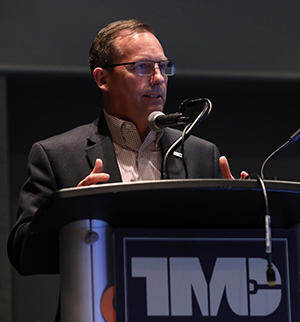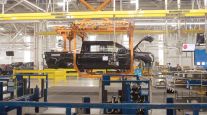Features Editor
Experts Offer Advice on Spec'ing EVs for Fleets

[Stay on top of transportation news: Get TTNews in your inbox.]
ORLANDO, Fla. — Industry insiders offered a glimpse into what goes into spec’ing electric vehicles for commercial fleet operations during a panel session at the American Trucking Associations’ Technology & Maintenance Council’s 2022 Annual Meeting & Transportation Technology Exhibition March 8.
Mike Roeth, executive director of the North American Council for Freight Efficiency, explained that the first step in electrification is to know your current business.
“It’s really important to understand at a very detailed level what you’re asking of your trucks,” he said. “What are the roles? The payload? The drivers? The weather and topography? You might be able to adjust some of that as you look at electric trucks. It’s really important to measure the performance of your fleet today.”
Jeff Glover, director of fleet maintenance at UPS Inc., stressed the need for and importance of OEM fleet support. UPS, which ranks No. 1 on the Transport Topics Top 100 list of the largest for-hire carries in North America, cycle tests every vehicle for durability, and expects a certain level of support from its OEM, he said.

Roeth speaks at the session. (John Sommers II for Transport Topics)
“Does the solution they offer support your 2% out-of-service criteria? Are they reachable on a national, regional or local level? And don’t forget about your parts; does the OEM have a robust path for supporting your parts?” he said. “Having an internal parts distribution center of your own is crucial, so reliance isn’t 100% on the OE.”
He added, “Do you have an alternative parts program? If not, it’s another path that (fleet managers) can look at to help reduce the downtime. Does anybody think the EV industry is to that point yet? We don’t.”
Gary Horvat, eMobility vice president at Navistar, broke down the spec process with his use of the “5Cs” — consulting utility services, charging stations, constructing infrastructure, connecting with OEM and other partners, and conserving energy.
“We think that this enterprise point of view is what you need needed to be successful and to really make sure that we support our customers throughout the process itself,” he said.
Bill Bliem, senior vice president of fleet services at motor carrier NFI, provided examples of utilizing an electric fleet. In 2021, the logistics provider was awarded funding for a Joint Electric Truck Scaling Initiative for California’s commercial deployment of battery-electric trucks. Bliem shared lessons learned through implementation of NFI’s electrification effort and repeatedly summed it up with one word.
Want more news? Listen to today's daily briefing above or go here for more info
“Efficiency, efficiency, efficiency is key to this whole thing. You need to know what it is,” he proclaimed. “You need to treat this like MPGs, only more because it’s that much more important. Range is a huge factor. This is why efficiency is so important.”
Bliem also stressed that fleet managers must know their limits when building infrastructure, and “then subtract” due to the fast pace of the technology’s evolution, and the threat of charging stations becoming outdated. “It’s never going to get better with age. It’s not like fine wine,” he said. “It’s going to decline.”
NFI ranks No. 16 on the TT Top 100 for-hire carriers list.
Bliem also raised the point that many unknowns exist concerning repair costs for electric vehicles.
“These parts scare me because — it’s still a theory — but some think maintenance is going to be a lot cheaper on electric vehicles versus diesel tractors,” he said. “I look at the parts, and when I see 24-volt cooling pumps, 24-foot DC converters and cooling energy storage systems and AC compressors, they just sound really expensive to me. And when they break, they’re going to cost a lot money to fix.”


&uuid=(email))



